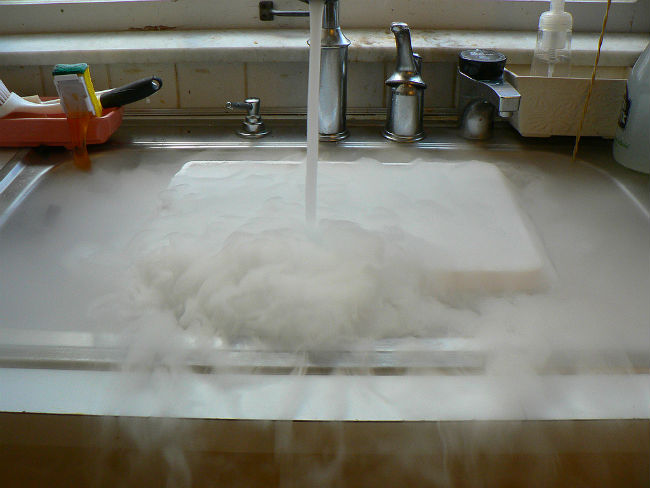We may earn revenue from the products available on this page and participate in affiliate programs. Learn More ›
Solidified carbon dioxide—better known as dry ice—is commonly used to freeze food or keep it cold longer than regular ice thanks to its frigid surface temperature of -109.3 degrees Fahrenheit. Available at grocery stores and home centers as blocks, pellets, or flakes, dry ice can be dropped into packages and coolers, used to flash-freeze foods, or relied on as a backup should the power go out to the fridge.
But dry ice can be dangerous: Touch it with bare skin and it can induce mild to severe frostbite in a matter of seconds. What’s more, because dry ice continuously releases carbon dioxide as it sublimates (aka evaporates), the gas buildup from storage in an airtight container with the lid shut could cause an explosion, injuring people or damage property nearby. And if allowed to sublimate in a closed-off area, the carbon dioxide gas could fill the enclosed space, leading to accidental suffocation.
Most people are aware that safety measures are crucial when using dry ice, but knowing how to dispose of dry ice properly is equally important to avoid the risks mentioned above. Read on to refresh yourself on the simple yet invaluable safety tips for handling and disposing of dry ice so that you can use the refrigerant without consequence.
Tools & Materials
Bobvila.com may earn a commission from purchases made through these links.
How to Dispose of Dry Ice
STEP 1: Pick the proper place and time.
Choose a well-ventilated space inaccessible to children or pets. An outdoor area like a backyard or fire escape is best. For fastest results, choose a cool, uncloudy day to dispose of dry ice; however, sublimation will still occur in warm, humid weather, so there’s no need to delay the task.
STEP 2: Dress for disposal.
Wear a long-sleeve shirt, closed-toe shoes, and insulated gloves to protect skin from coming into direct contact with the dry ice.

STEP 3: Speed up sublimation.
Retrieve unused dry ice from the cooler, fridge shelf, or container in which it was stored. If you wrapped the dry ice in newspaper pages (often recommended to keep the ice from touching food items), remove the newspaper, set it aside, and place the unused dry ice inside a Styrofoam chest or a lidded plastic container. Replace the lid, leaving it slightly ajar—securing it completely can cause gas buildup. With the lid ajar, carbon dioxide can safely and swiftly escape into the atmosphere.
STEP 4: Let it sit to sublimate.
Set the container on a flat surface and allow to dwell until the dry ice completely evaporates and no solids remain. It generally takes 24 hours for five to 10 pounds of dry ice to sublimate. Avoid lingering in the vicinity to prevent overexposure to carbon dioxide, which causes such symptoms as nausea, headaches, and vomiting. If you must be in the area, wear a respirator to mitigate gas exposure.
STEP 5: Dispose of the container correctly.
Once the dry ice has fully evaporated, dispose of the container (along with the gloves used to handle it and the newspaper used to wrap it) at a local waste collection site or landfill that accepts hazardous waste products. To locate one, check your city’s environmental services website or refer to the website of a hazardous waste collection company like WM At Your Door for pick-up services in your area.

What NOT to Do with Dry Ice
disposal.
NEVER:
- Touch dry ice with bare skin.
- Lay dry ice directly on a solid-surface or tiled countertop—it could crack the surface.
- Expose unsealed food in your fridge directly to dry ice, which can freeze foods on contact. If flash-freezing items like fish, place food in a freezer bag or vacuum-seal it prior to dry ice exposure.
- Store more than 10 pounds of dry ice in your fridge per day. Any more than that creates the potential for excess carbon dioxide buildup inside the appliance.
- Store dry ice in the freezer compartment of your fridge; it can bring the overall temperature of the freezer below its programmed temperature and may cause freezer malfunction.
- Dump dry ice near local sewer lines or down the garbage disposal, toilet, or sink drain; it can cause pipes to freeze and burst.
- Discard dry ice in garbage chutes, trash cans, or other confined or inadequately ventilated spaces such as a pantry. As dry ice evaporates, carbon dioxide would fill the enclosed space and could cause accidental suffocation. Also, because carbon dioxide is heavier than oxygen, it has a tendency to drift into low-lying areas like basements, where it could gradually replace oxygen and fill the room with carbon dioxide.
- Dump dry ice in public areas accessed by people or pets.
- Transport dry ice in a vehicle without adequate ventilation. Open one or more windows when transporting dry ice in your car. If you must keep windows closed, turn off the indoor air re-circulation option (usually located on the center console) to circulate new air from the outside into the car for maximum ventilation. Avoid transporting the dry ice for more than 15 minutes at a time to prevent carbon dioxide overexposure.

